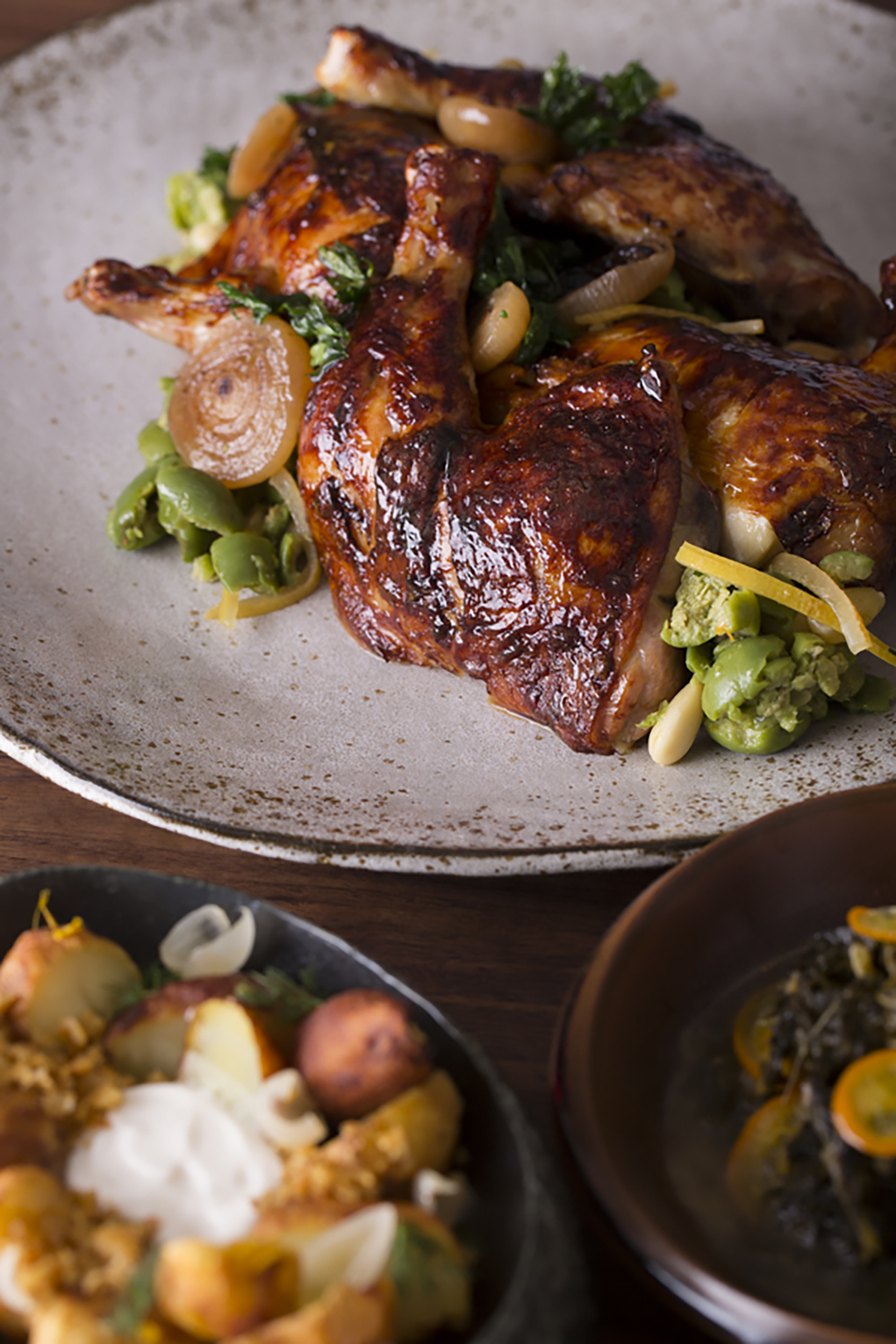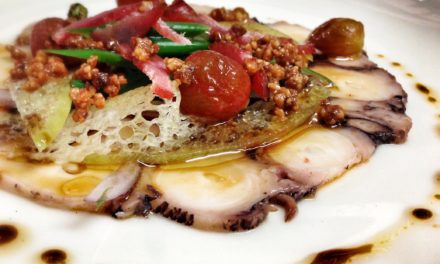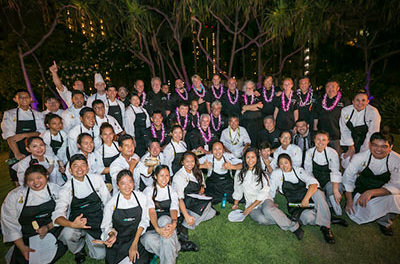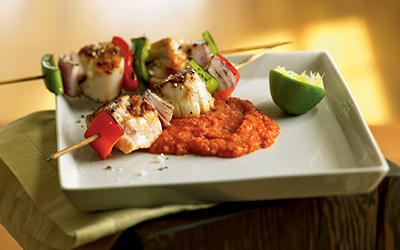Originally published in the Taste Our Love for the Land cookbook, published 2015.
These days, all over the U.S. and throughout the world, there has been a great deal of dialogue and debate about sustainability in food. Chefs, farmers, journalists and writers are asking how we can move forward while stepping backward to a world, and a time, in which environmental sustainability was the norm—a time when people instinctively maintained a delicate balance between what they produced from the earth, the waste they generated in the process, and their ability to replace the resources they used and supplement these resources with renewable ones. It’s a conversation that reminds us that to sustain healthy lives and a healthy earth, people were once participants in the natural process of life—not designers trying to reinvent it in new ways.
I think the current sustainability discussion evolved out of the organics movement. What started as a genuine effort to produce food in a more natural and responsible way has become an increasingly fraught issue. Along with all the profoundly positive transformations it has brought, from growing practices to the explosion of farmers markets, “organic” has also become a marketing tool that is often simply a way to charge a premium for products that were not necessarily produced in a sustainable way.

“The focus should not only be on the food we consume, but on the people who make it possible for us to enjoy it.”
Chef Mourad Lahlou: “Irresponsible food production is threatening the future of our species and our planet.” Photos: courtesy of Mourad Lahlou/“Taste Our Love for the Land,” 2015
When people started to question the real meaning of “organic,” the concepts of “sustainable” and “local” entered the discussion as a way to get closer to what had really driven the organic movement from the start. This new point of view allowed us to think about food not just in terms of production, but also in terms of a more holistic environmental perspective. It is not enough that a carrot was grown organically. Now, we’re becoming increasingly conscious of the environmental implications that went into growing that carrot. Sourcing foods locally to limit their carbon footprints is a huge step toward safeguarding the earth for future generations.
With the rise in obesity, heart disease, cancer and diabetes on the one hand and climate change and pollution on the other, irresponsible food production is threatening the future of our species and our planet. And yet, we have to feed a hungry world, and we need the help of science and technology to do that.
We also need the help of a sustainable labor force. We cannot talk about environmental
sustainability without recognizing the people who are responsible for growing, harvesting, delivering, cooking and serving our food—growers who can barely afford the products they grow; cooks who cannot eat at restaurants where they slave away every day or even live in the cities where they work; dishwashers who sleep in bunk beds in crowded rooms; and food runners who don’t have the luxury of getting sick and missing work. It has become blatantly obvious that the focus should not only be on the food we consume, but on the people who make it possible for us to enjoy it.
If we don’t address these issues collectively, we cannot pretend we are doing our share in achieving environmental sustainability. I hope in the years ahead that we’ll all be adding the idea of sustainable justice to the conversation about sustainable food and agriculture.
We no longer have the luxury of pleading ignorance.
Roast Chicken with Preserved Lemon
Serves 6-8 | By Mourad Lahlou

Roast Chicken with Preserved Lemon
Serves 6-8 | By Mourad Lahlou
2 air-chilled chickens (3½ pounds each), excess fat removed
Chicken Brine (recipe follows)
3 preserved lemons (450 grams)
8 thyme sprigs (8 grams)
Kosher salt
8 tablespoons unsalted butter, at room temperature
Serve with Couscous with Meyer Lemon and Parsley (recipe follows).
Prepare brine. If the brine isn’t completely cold, refrigerate until it is. Add the chickens to the cold brine, and weight them with a plate or small pot lid to keep them submerged. Refrigerate for 8 to 12 hours.
Cut the preserved lemons into quarters. Cut the flesh away from the rinds, and reserve both the rinds and flesh. Remove the chickens from the brine (discard brine), rinse them, and dry well with paper towels. Place one chicken on a work surface, with the legs facing you. Starting at the cavity, work the handle of a wooden spoon between the skin and one breast to create a pocket, working slowly and gently to avoid tearing the skin. Repeat on the other side. Holding the chicken in place with one hand, slide the index and middle fingers of your other hand into each pocket to enlarge it, then slide your fingers down to create a pocket over the thigh. Repeat with the second chicken.
Insert the pieces of preserved lemon rind, white pith side down, and thyme sprigs into the pockets over the thighs and breast. Sprinkle the cavities with salt, and rub the chickens with the reserved flesh from the preserved lemons.
I like to truss the poultry without using kitchen twine, which saves tying and untying them and makes for a more natural presentation. Position chicken breast side up, with the legs facing you. Cut a vertical slit in one side, about one inch back from the cavity, alongside the thigh. Cross the end of the opposite drumstick over the drumstick on this side and poke the end of the upper drumstick through the slit. (Depending on the condition of the chicken’s skin, it may rip as you try to poke the drumstick through it, so have some kitchen twine on hand just in case, and tie the legs together if necessary.) Repeat with the other chicken. Sprinkle the chickens with salt. Preheat the oven to 500°F.
Set the chicken breast side up in a roasting pan. Roast for 15 minutes. Spread the butter over the breasts. Roast for another 45 to 50 minutes, or until the skin is richly browned and the temperature in the meatiest sections registers 160°F. Remove from the oven. Rest chickens on a carving board for 20 minutes.
Present the chickens whole or carved, arranged on either the roasting pan or a large platter.
Chicken Brine
4 quarts cold water
¾ cup granulated sugar
1½ cups kosher salt
2 lemons, cut into quarters
1 cup cracked green olives, with the brine
12 flat leaf parsley sprigs
2 tablespoons sliced garlic
1 tablespoon Tellicherry peppercorns
8 thyme sprigs
10 bay leaves
4 quarts ice cubes
Put the water in a 10- to 12-quart stockpot, and bring to a simmer. Add the brine ingredients, except ice, and stir to dissolve the sugar and salt. Turn off the heat and let sit at room temperature for 20 minutes to infuse the flavors. Add ice to chill the brine.
Couscous with Meyer Lemon and Parsley
Serves 6
7 Meyer or regular lemons
⅔ cup water
3½ tablespoons granulated sugar
6 tablespoons extra-virgin olive oil
6 cups Classic Steamed Couscous*, still hot
1½ teaspoons finely chopped flat leaf parsley
Kosher salt
Using a vegetable peeler, cut away the peel and part of the pith of the lemons in strips about ⅛-inch thick. Cut the peel into ⅛-inch dice; you need a scant 1 cup. Juice enough of the lemons to make 6 tablespoons.
Combine the lemon peel, lemon juice, water and sugar in a small saucepan, and bring to a simmer. Cook for 5 to 6 minutes, or until the lemon peel is tender. Remove peel (do not discard liquid; this will be the base for a vinaigrette) and drain in a strainer set over a small bowl. Set aside.
Whisk 3 tablespoons of the olive oil into the reserved syrup, and let cool to room temperature. Stir 1 cup of this vinaigrette, and the reserved peel, into the couscous, along with the parsley and remaining 3 tablespoons olive oil. Season to taste with salt and additional lemon vinaigrette.
*The recipe for Classic Steamed Couscous can be found in my cookbook, “Mourad: New Moroccan.”



